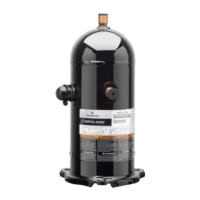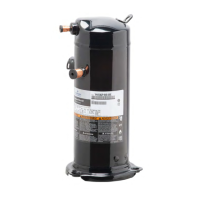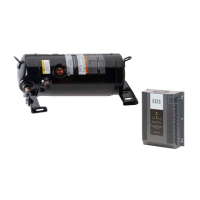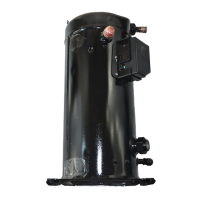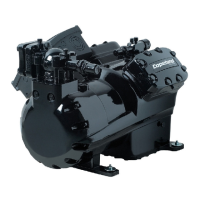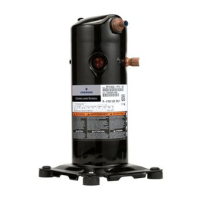AGL_HP_VS_YHV_RG_RT_EN_Rev00 31
if the tubing is routed at least 15 cm above the compressor. After several minutes of operation in
reverse, the compressor's protection system will trip due to high motor temperature. The operator
will notice a lack of cooling. However, if allowed to repeatedly restart and run in reverse without
correcting the situation, the compressor will be permanently damaged.
All three-phase scroll compressors are identically wired internally. Therefore, once the correct
phasing is determined for a specific system or installation, connecting properly phased power leads
to the identified compressor terminals will ensure proper rotation direction.
5.9 Start-and-stop routine
The drive controls the start-and-stop routine of the variable-speed scroll. This routine allows for soft
starting and controlled stopping, an advantage over traditional on/off control of fixed capacity units.
NOTE: For more information about this topic please refer to the ED3 & EV3 User Manuals.
5.10 Start-up and shut-off sound
During the very brief start-up, a clicking sound resulting f rom the initial contacting of the spirals is
audible; this sound is normal. Due to the design of the Copeland scroll compressors, the internal
compression components always start unloaded even if system pressures are not balanced. In
addition, since internal compressor pressures are always balanced at start-up, low-voltage starting
characteristics are excellent for Copeland scroll compressors.
Scroll compressors incorporate a device that minimizes reverse rotation. The residual momentary
reversal of the scrolls at shut-off will cause a clicking sound, but it is entirely normal too and it has no
effect on compressor durability.
5.11 Deep vacuum operation
CAUTION
Vacuum operation! Compressor damage! Copeland scroll
should never be used to evacuate refrigeration or air-
Operating scroll compressors in deep vacuum could damage internal motor
parts and lead to unacceptably high temperatures in the compressor housing.
WARNING
Operation below ambient pressure! Fire hazard! During operation of A2L-
or A3-refrigerant systems below ambient pressure, a f lammable
form inside the system. Make sure that air does not enter the system and that
the pressure never falls below atmospheric pressure.
5.12 Shell temperature
During normal operation, the discharge gas as well as the compressor top shell and discharge line
can reach temperatures up to the maximum discharge gas temperature
see section 3.77
"Discharge gas temperature protection".
In a failure mode, the discharge gas temperatures can even get higher. Care must be taken to ensure
that wiring or other materials that could be damaged by these temperatures do not touch the shell.
5.13 Pumpdown cycle
WARNING
Vacuum operation! Creation of a flammable mixture! Fire hazard!
operation of A2L- or A3-ref rigerant systems in vacuum a flammable mixture
can form inside the system. Extreme attention shall be paid to system
tightness. Prevent ambient air from entering the system.
Vacuum operation! Compressor damage!
Compressor operation outside
the operating envelope is not allowed
A pumpdown cycle to control refrigerant migration may have to be used for several reasons, for
example when the compressor is located outdoors without any housing so that cold air blowing over
the compressor makes the crankcase heating function ineffective.

